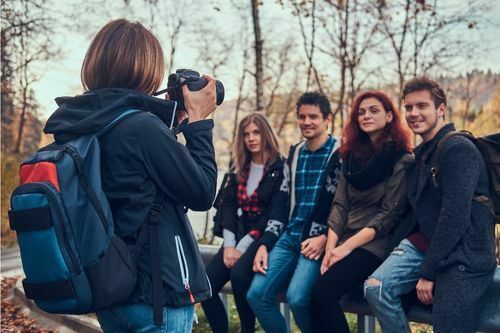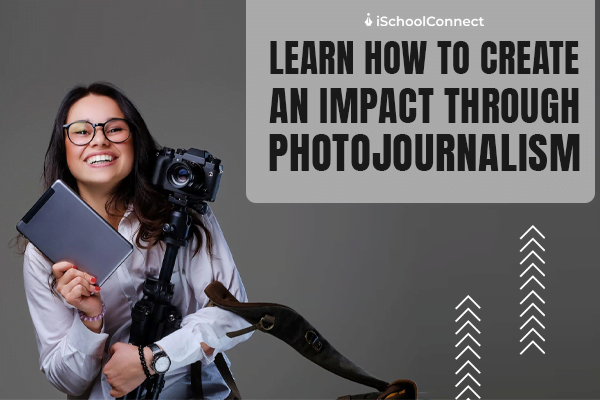Table of Contents
In other words, photojournalism is a form of photography that uses pictures or other visuals to tell a story. A photojournalist is a person who works in this field.
Images by photojournalists appear in print publications like newspapers and magazines as well as non-conventional visual outlets like websites and blogs. Many photojournalists work independently. But their work can also be seen in newspapers and journals and their writings are frequently published as standalone features. For these photojournalists, picture blogs are a crucial medium to showcase their talent.
What is photojournalism?
Photojournalism is the art of telling a story using photos as your primary means of expression. A photojournalist uses a camera to record the visual depiction of a story, whereas a journalist uses pen and paper to communicate stories.
“a picture is worth a thousand words”.
We all know this and this is the underlying theory of photojournalism. You can use pictures to tell a story rather than telling it through words. For photojournalists who can capture the most spectacular photographs on film or their CCD chip, news organizations are willing to pay top bucks.
Types of photojournalism

Spot news photojournalism
It is the coverage of unplanned and often unpleasant occurrences like air crashes, road accidents, etc.
General news photojournalism
Just as the name suggests it deals with coverage of planned events like press conferences and other official events.
Feature photojournalism
It includes coverage of any non-news-related events or occurrences. It mainly focuses on pictures that are meant to entertain people.
Sports action photojournalism
It deals with covering important events occurring in the world of sports.
Portrait/personality photojournalism
Portrait or personality photojournalism deals with conveying the emotions of the person being photographed.
Pictorial photojournalism
It deals with producing outstanding images that are meant to showcase the artistic side of photojournalism.
Illustration photojournalism
It deals with manipulating two different images to create a new image which helps in conveying a message which may or may not is related to what is being photographed in the images.
Basics of photojournalism
Light
Light emphasizes important aspects in a frame and aid to create a certain mood in a shot. Similar to how it can generate a mix of highlights and shadows, light can also assist an image gain depth and accentuating its textures.
Color
One of the key elements in a photograph that contributes to its enigmatic, thrilling, depressing, or dismal feeling is color. Strong images must evoke strong emotions, and one of our main instruments for doing this is color. Again, this is a complex subject that is beyond the scope of this blog but remembers that selecting the right colors for our photographs can effectively evoke a range of feelings and leave a lasting impression on the viewer.
Moment
Highlighting a specific topic or event in time is only one aspect of a powerful moment. Each component of the image should interact with the others in such a way that the spectator has to say, “Wow, this looks special!”. This is how you create a moment in a photograph.
Composition
Composition is the process of arranging the elements in your frame to highlight the elements you want to stand out. Although the composition of a photograph is highly subjective, a superb composition can elevate an average scene to an attention-grabbing visual.
Distance
The feeling and overall impact of an image will depend on how far away from the subject the photographer positions themselves. It will also help you decide at what focal length you should take the photo to fit all of the essential elements into the frame.
Top 5 photojournalism colleges in the world

George Washington University
Your undergraduate photojournalism degree will be from Corcoran College of the Arts and Design if your application is accepted at George Washington University. Internships with reputed newspapers based in the DC region are offered while studying and in their photojournalism course.
The course material includes fundamental principles and practices of journalism. Studies of light, composition, and color in photography are also covered, along with instruction in multimedia technologies.
University of Arts London
Only the best applicants for each semester are accepted due to the high entrance requirements. These top candidates will graduate as exceptionally well-trained photojournalists thanks to the skills they will acquire in the degree programs.
A degree from UAL will also help you get a foot in the door of important news organizations all across the world.
Rochester Institute of Technology
The photojournalism department at RIT is one of the best among all the polytechnical colleges for a variety of different disciplines of study, and it grants undergraduate and graduate degrees along with a top-notch education.
A BS or BFA in photography is offered here, and RIT provides a specialization in photojournalism. It’s a medium-sized institution where numerous courses are taught.
Attending a polytechnic school like this one also has the benefit of encouraging a cross-disciplinary approach to a well-rounded education.
California College of Arts
The education provided here is multidisciplinary. The CCA staff actively promotes exchanging concepts, targets, and strategies. This school places a lot of emphasis on the photographic side of photojournalism, emphasizing the importance of storytelling in documentary and journalistic photography.
Undergraduate and graduate degrees are also available, and you can apply for numerous minor courses in many Arts and Design disciplines.
University of Central Florida
A BS in Photography degree program is available from UCF, and it includes classes like Photo Visualization and Narrative Editorial Photography, which are essential for photojournalists.
The degree program is split between the nearby Daytona State College and UCF. Students can benefit from the networking opportunities offered by attending two universities, which helps in professional growth.
Eligibility criteria for photojournalist courses
- A degree with honors in the arts or another related field
- Bachelor of Arts in Photography with qualifying scores
- If you lack a formal degree, you must have at least three years of professional experience working for a publishing company (or as a freelancer), as well as the ability to enroll in Postgraduate-level coursework.
- A collection or portfolio of your finest works
These criteria might change for different universities as their admission processes also differ.
Key takeaways
- Photojournalism is a way of storytelling through photographs and images. This is an extensive field of work with lots of career opportunities.
- There are 5 basic principles of photojournalism that help in capturing effective images to convey a strong message.
- Many renowned universities provide photojournalism courses which can help in getting better job opportunities in the best publication and newspaper houses.
Hope you found this blog helpful. For more information on photojournalism, click here.
Liked this blog? Read next: Journalism course | A guide for aspiring Journalists!
FAQ
Q1. Is food photojournalism a good career option?
Ans- Food photojournalism has a promising future, but there is still a huge market in the world that goes unexplored. Hotels, restaurants, ice cream and dairy businesses, exporters, recipe book and magazine agencies, and newspapers are a few of the key clientele of food photojournalism
Q2. Which colleges offer photojournalism courses in India?
Ans- Colleges that provide photojournalism and photography courses:
- Amity school of journalism & Communication
- Amrit College, Trivandrum
- Asian college of journalism, Chennai
- Bharathiya Vidhya Bhavan units at Trivandrum, Kottayam, Thrissur, Kochi, Kozhikode, and other cities in India.
- Bhavan’s Institute of Communication & Management, Mumbai
Q3. What degree should I apply for to become a photojournalist?
Ans-A bachelor’s degree in journalism, visual communications, or photography is usually required to get a job as a photojournalist. Having an extensive work portfolio is also important for seeking employment.






